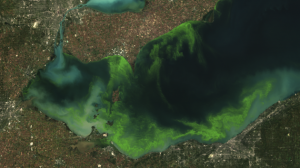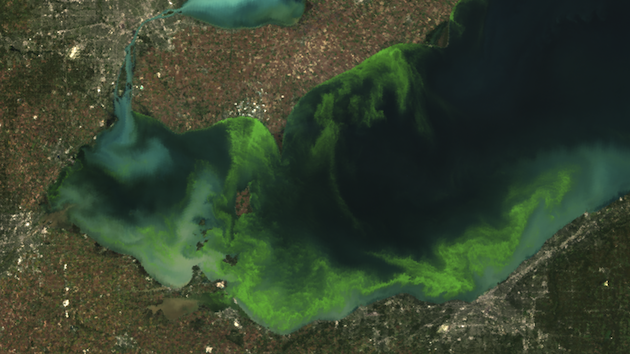Beyond Toledo: Toxic Water in a Hotter World
By: Karen Baumert
In August 2014, Toledo, Ohio’s tap water became undrinkable, leaving about 500,000 people without water. The cause: a toxic algae bloom in Lake Erie near Toledo’s water intake. To talk about how global climate change affects the occurrence of harmful algae blooms and their effects on our health, Bard Center for Environmental Policy (CEP) sat down with Dr. Robyn Smyth of the Bard policy center and Dr. Aris Efting from the Bard Early College High Schools, as part of The National Climate Seminar. Among the interesting news: toxic-producing bacteria have evolved clever mechanisms to outcompete friendlier algae. And, chronic exposure to algae toxins may be linked to degenerative neurological diseases like Alzheimers.
An edited selection from the conversation is below. You can listen to the full podcast HERE. The full line-up of National Climate Seminar speakers is HERE.
BARD CEP: What are harmful algae blooms?
SMYTH: Harmful algal blooms episodes of runaway growth of phytoplankton that poses a threat to human, animal, or ecological health. Not all blooms are harmful, but they can be when the algae growth shades out other organisms or uses up too much oxygen when it decays, which can result in fishkills. Other blooms are harmful because they produce toxins that are detrimental to humans and wildlife.

BARD CEP: What causes algae blooms?
SMYTH: The main trigger for algae blooms is an increased supply of the nutrients that limit their growth. Algae are like crops, they grow better when you fertilize them and that’s what is happening from our activities on land. Excess fertilizers that aren’t used by crops and grass get washed into lakes. Leaking septic systems and sewer overflows are also fertilizing aquatic ecosystems with excess nutrients.
BARD CEP: How does global climate change affect algae blooms?
SMYTH: Warming temperatures are giving toxin-producing cyanobacteria, also called blue-green algae, a competitive advantage over other non-toxic species. First, cyanobacteria tend to have higher growth optima meaning they like to grow at water temps of 25°C (77°F) or greater whereas for most other species it is 5-10 degrees lower. Warmer water helps cyanobacteria outgrow their competition.
Climate warming also has a physical effect on lakes that also favors cyanobacteria. Thermal stratification, where warm water that is less dense sits stably atop cold water, is a barrier to mixing that favors cyanobacteria because they have gas vacuoles that they can inflate and float to top under stable conditions. Because they’ve evolved pigments that protect them from the high light at the surface, they can form dense mats that shade out their competitors. They’re also the only algae species that can use nitrogen directly from the atmosphere to fuel their growth. If they run out of other nutrients, they can empty their vacuoles, sink down, get what they need and float back up. These organisms are thriving in the environment that we’re creating in our lakes with excess nutrient loading and climate change. As climate warms, many of our freshwater lakes are also becoming more saline. Cyanobacteria can tolerate saline conditions better than other freshwater algae so this increase in salinity may also promote blooms.
BARD CEP: What are some of the health effects of cyanobacteria’s toxins?
EFTING: The toxins that some blooms create pose a serious threat to human and animal health. Cyanobacteria can produce skin, liver, and neurotoxins. Recent research suggest chronic exposure to toxins, specifically BMAA, found in both freshwater and marine systems can lead to neurodegenerative diseases such as ALS, Parkinson’s, and Alzheimer’s, over time. But not all blooms produce toxins. More research is needed to understand what triggers toxin production in bloom forming species.
BARD CEP: What can we do to manage algae blooms?
SMYTH: One of the main things we can do is limit the phosphorus loading. We can go after the point sources by upgrading wastewater treatment plants and other industrial point sources. We can also go after non-point sources such as fertilizers and manure used in agriculture as well as test and upgrade septic systems. Since much of the phosphorus is locked up in lake sediment, even with phosphorus loading reductions, it will take a long time to flush out the excess nutrients.
When it comes to Lake Erie, which borders multiple states and two countries, there needs to be a cooperative agreement to manage the algae blooms. Federal funding will have to be provided and the responsibilities will have to be allocated. All the players need to come to the table and figure out the maximum loading of phosphorus that can go into Lake Erie on a daily basis.
We need to increase monitoring, funding, and the amount of interdisciplinary research that allows us to couple an understanding of complex biological systems with a complex physical system. This will provide us with a predictive understand of how to better protect our water supply.
In conclusion…
Algae blooms pose a health threat to both humans and the environment. With toxin producing algae being able to outcompete other algae in warmer waters, we should expect to see more harmful algae blooms as we feel the effects of global climate change. By researching the harmful algae, we will have a better understanding of how to manage the blooms and protect our water resources.


